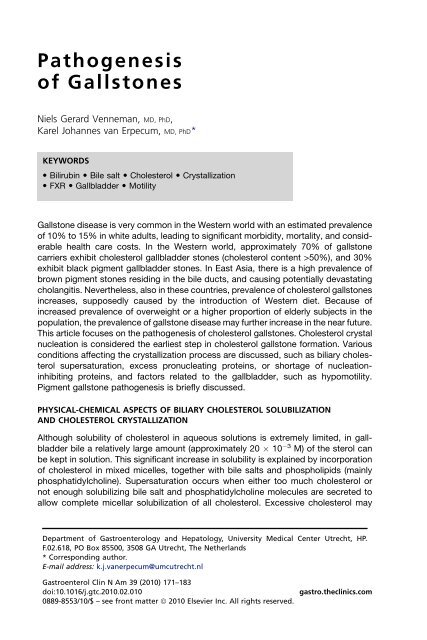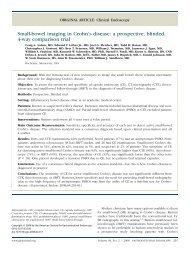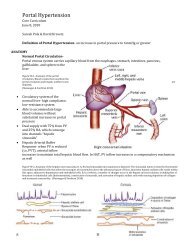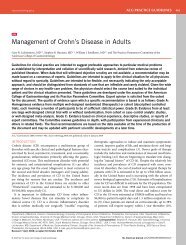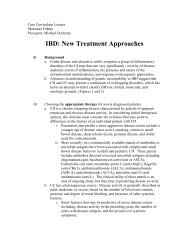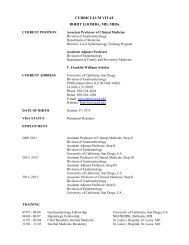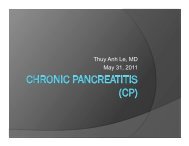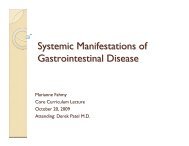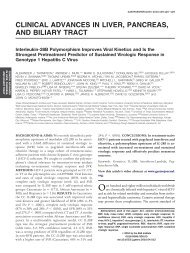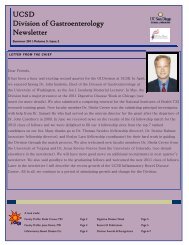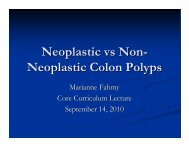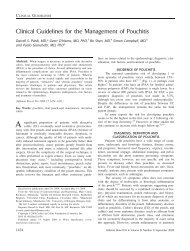Pathogenesis of Gallstones
Pathogenesis of Gallstones
Pathogenesis of Gallstones
Create successful ePaper yourself
Turn your PDF publications into a flip-book with our unique Google optimized e-Paper software.
<strong>Pathogenesis</strong><strong>of</strong> <strong>Gallstones</strong>Niels Gerard Venneman, MD, PhD,Karel Johannes van Erpecum, MD, PhD*KEYWORDS Bilirubin Bile salt Cholesterol Crystallization FXR Gallbladder MotilityGallstone disease is very common in the Western world with an estimated prevalence<strong>of</strong> 10% to 15% in white adults, leading to significant morbidity, mortality, and considerablehealth care costs. In the Western world, approximately 70% <strong>of</strong> gallstonecarriers exhibit cholesterol gallbladder stones (cholesterol content >50%), and 30%exhibit black pigment gallbladder stones. In East Asia, there is a high prevalence <strong>of</strong>brown pigment stones residing in the bile ducts, and causing potentially devastatingcholangitis. Nevertheless, also in these countries, prevalence <strong>of</strong> cholesterol gallstonesincreases, supposedly caused by the introduction <strong>of</strong> Western diet. Because <strong>of</strong>increased prevalence <strong>of</strong> overweight or a higher proportion <strong>of</strong> elderly subjects in thepopulation, the prevalence <strong>of</strong> gallstone disease may further increase in the near future.This article focuses on the pathogenesis <strong>of</strong> cholesterol gallstones. Cholesterol crystalnucleation is considered the earliest step in cholesterol gallstone formation. Variousconditions affecting the crystallization process are discussed, such as biliary cholesterolsupersaturation, excess pronucleating proteins, or shortage <strong>of</strong> nucleationinhibitingproteins, and factors related to the gallbladder, such as hypomotility.Pigment gallstone pathogenesis is briefly discussed.PHYSICAL-CHEMICAL ASPECTS OF BILIARY CHOLESTEROL SOLUBILIZATIONAND CHOLESTEROL CRYSTALLIZATIONAlthough solubility <strong>of</strong> cholesterol in aqueous solutions is extremely limited, in gallbladderbile a relatively large amount (approximately 20 10 3 M) <strong>of</strong> the sterol canbe kept in solution. This significant increase in solubility is explained by incorporation<strong>of</strong> cholesterol in mixed micelles, together with bile salts and phospholipids (mainlyphosphatidylcholine). Supersaturation occurs when either too much cholesterol ornot enough solubilizing bile salt and phosphatidylcholine molecules are secreted toallow complete micellar solubilization <strong>of</strong> all cholesterol. Excessive cholesterol mayDepartment <strong>of</strong> Gastroenterology and Hepatology, University Medical Center Utrecht, HP.F.02.618, PO Box 85500, 3508 GA Utrecht, The Netherlands* Corresponding author.E-mail address: k.j.vanerpecum@umcutrecht.nlGastroenterol Clin N Am 39 (2010) 171–183doi:10.1016/j.gtc.2010.02.010gastro.theclinics.com0889-8553/10/$ – see front matter ª 2010 Elsevier Inc. All rights reserved.
172Venneman & van Erpecumbe kept in vesicles (ie, spherical bilayers <strong>of</strong> cholesterol and phospholipids, without bilesalts) or in cholesterol crystals. Cholesterol crystal nucleation is thought to occur ingeneral from vesicles supersaturated with cholesterol (ie, vesicular cholesterol/phospholipidratio >1). 1 First, small unilamellar supersaturated vesicles aggregate or fuseinto larger multilamellar vesicles (‘‘liquid crystals’’), with subsequent phase-separation<strong>of</strong> cholesterol crystals. 2 Pivotal information on the process <strong>of</strong> cholesterol crystal nucleation,the earliest step in cholesterol gallstone formation, 3 has been obtained from invitro studies in model bile systems. Wang and Carey 4 found that cholesterol crystallizationpathways and sequences in human gallbladder biles are identical to model bilesmatched for all relevant physical-chemical conditions, underlining the relevance <strong>of</strong> themodel bile data. Based on these model bile data, the equilibrium bile salt–phospholipid–cholesterolternary phase diagram was constructed, which allows one to predictbehavior <strong>of</strong> mixtures <strong>of</strong> the three biliary lipids when present in various proportions. 5 Asshown in Fig. 1, the phase diagram contains a bottom one-phase zone (only micelles);Fig. 1. Equilibrium bile salt–phospholipid–cholesterol phase diagram. The components areexpressed in mol percent. Depicted are a one-phase (micellar) zone at the bottom; a lefttwo-phase zone (containing micelles and crystals); a central three-phase zone (containingmicelles, vesicles and crystals); and a right two-phase zone (containing micelles and vesicles).Phospholipid/(bile salt 1 phospholipid) ratios are given at the bottom axis, and going fromleft to right indicates increased relative amounts <strong>of</strong> phospholipids compared with bile salts,with increased vesicular cholesterol solubilization. Any line connecting the bottom axis withthe top <strong>of</strong> the triangle (100% cholesterol) represents identical phospholipid/(bile salt 1phospholipid) ratio, with increased relative amounts <strong>of</strong> cholesterol when moving frombottom to top. For example, in the Figure, all biles plotting on the coarse interruptedline exhibit identical phospholipid/(bile salt 1 phospholipid) ratio <strong>of</strong> 0.8. In the Figure,fine lines indicate zones in case <strong>of</strong> diluted bile, hydrophilic bile salts or saturated phospholipidacyl chains. Thick lines indicate zones in case <strong>of</strong> concentrated bile, hydrophobic bilesalts, or unsaturated phospholipid acyl chains. Under the latter circumstances, cholesterolcrystallization is promoted by an expansion <strong>of</strong> the crystal-containing zones to the right.The bile sample initially plotting in the right two-phase zone (indicated by the dot) nowplots in the central three-phase zone (cholesterol crystal-containing zone), despite identicalrelative lipid composition.
<strong>Pathogenesis</strong> <strong>of</strong> <strong>Gallstones</strong> 173a left two-phase (micelles and cholesterol crystals containing) zone; a central threephase(micelles, vesicles, and cholesterol crystals containing) zone; and a right twophase(micelles and vesicles containing) zone. Going from baseline to top in the phasediagram the relative percentage <strong>of</strong> cholesterol increases, with progressive tendency <strong>of</strong>cholesterol crystallization as a result. Second, a shift from left to right in the phasediagram increases relative amounts <strong>of</strong> phospholipids compared with bile salts, allowingmore solubilization <strong>of</strong> cholesterol in vesicles, lower vesicular cholesterol/phospholipidratios, and less cholesterol crystallization as a result. If gallstones are present insupersaturated bile, competition may occur between the gallstone surface (gallstonegrowth) and the surrounding bile for available cholesterol molecules. 6 Three factorsstrongly affect the ternary equilibrium bile salt–phospholipid–cholesterol ternary phasediagram, with potential consequences for in vivo cholesterol crystallization: (1)increased bile concentration, (2) increased bile salt hydrophobicity, and (3) phospholipidscontaining unsaturated acyl chains all strongly promote cholesterolcrystallization. Corresponding effects on the ternary equilibrium bile salt–phospholipid–cholesterolternary phase diagram are in all three cases an increase <strong>of</strong> the bottomone-phase (micellar) zone, an expansion <strong>of</strong> the cholesterol crystal–containing zones tothe right, and a decrease <strong>of</strong> the vesicles-containing zones (see Fig. 1). 5,7BILE CONCENTRATIONWater is a major component <strong>of</strong> bile. Significant net water absorption occurs during biletransfer through the bile ducts and during prolonged storage in the gallbladder. Asa result, bile water content decreases from 97% weight in the bile ducts to 90% weightin the gallbladder. This threefold to fourfold concentration <strong>of</strong> bile enhances cholesterolcrystallization and gallstone formation considerably. 8,9 During the process <strong>of</strong> bileformation, detergent bile salt monomers first induce formation <strong>of</strong> nascent cholesterol-phospholipidvesicles in the bile canalicular space. These vesicles are stablebecause they are relatively cholesterol-poor (cholesterol/phospholipid ratio 1) and may nucleatecholesterol crystals. This sequence explains why gallstones are generally formed inthe gallbladder rather than in the bile ducts.BILE SALT HYDROPHOBICITYMore hydrophobic bile salts strongly promote cholesterol crystallization, by affectingthe ternary phase diagram in a similar way as bile concentration (increased micellarcholesterol solubilization, shift <strong>of</strong> crystal-containing zones to the right, cholesterolsupersaturated vesicles, promotion <strong>of</strong> cholesterol crystallization 5 ). In the animalkingdom, human bile exhibits the most hydrophobic bile salt composition, with strongpropensity to gallstone formation. Nevertheless, there is considerable variation inhydrophobicity <strong>of</strong> human bile salt composition (especially amounts <strong>of</strong> deoxycholate).In gallbladder bile <strong>of</strong> cholesterol gallstone patients, increased amounts <strong>of</strong> the hydrophobicbile salt deoxycholate are associated with fast crystallization. 10 The primarybile salts cholate and chenodeoxycholate are synthesized from cholesterol in the liver,
174Venneman & van Erpecumand secondary bile salts (mainly deoxycholate) are formed from primary bile salts inthe intestine by bacterial 7a-dehydroxylase activity. Interestingly, gallstone patientsexhibit larger amounts <strong>of</strong> bacteria and more 7a-dehydroxylase activity in cecal aspiratesin conjunction with higher colonic pH values and prolonged small and largebowel transit times, all favoring solubilization and absorbtion <strong>of</strong> deoxycholate intothe enterohepatic circulation. 11 Because <strong>of</strong> the presence <strong>of</strong> Lith genes, male C57Linbred mice are highly susceptible to cholesterol gallstone formation during lithogenicdiet, provided that a hydrophobic biliary bile salt composition (quite hydrophilic atbaseline) is obtained by dietary measures (15% fat, 1% cholesterol, 0.5% cholicacid), supporting a role for bile salt composition in gallstone formation. 12 Modulatingbiliary bile salt composition may have therapeutic consequences. In selected patientswith cholesterol gallstones, treatment with the hydrophilic bile salt ursodeoxycholatemay dissolve their stones. Under these circumstances, 30% to 60% <strong>of</strong> the total bilesalt pool consists <strong>of</strong> ursodeoxycholate, with the result that cholesterol crystallizationis inhibited.BILIARY PHOSPHOLIPID COMPOSITIONIn in vitro studies with model biles, phospholipid class and phospholipid acyl chaincomposition exert pr<strong>of</strong>ound effects on cholesterol crystallization. Similar to increasedbile concentration and increased bile salt hydrophobicity, phospholipids with moreunsaturated acyl chains affect the ternary equilibrium bile salt–phospholipid–cholesterolternary phase diagram by increasing the bottom one-phase (micellar) zone,expanding the cholesterol crystal–containing zones to the right and decreasing thevesicles-containing zones, with the result that cholesterol supersaturated vesiclesand cholesterol crystallization occur (see Fig. 1). 7 The underlying physical-chemicalexplanation for these findings is that phospholipids with saturated acyl chains by their‘‘trans’’ configuration fit easily in the vesicular cholesterol-phospholipid bilayer, whichis not the case for phospholipids with cis-unsaturated acyl chains with a bend in themolecule (leading to preferential micellar containment). Human biliary phospholipidcomposition is tightly regulated, however, and almost exclusively composed <strong>of</strong> phosphatidylcholinewith unsaturated acyl chains (mainly 16:0 acyl chains on sn-1 position,18:2 > 18:1 > 20:4 acyl chains on sn-2 position), contributing to human vulnerability forgallstone formation. 13 Although modification <strong>of</strong> biliary phospholipids toward a moresaturated acyl chain composition is in theory attractive, dietary modifications toaccomplish this have not been successful.BILIARY NUCLEATION PROMOTING AND INHIBITING PROTEINSDuring the last decades, numerous biliary proteins have been suggested to enhanceor inhibit cholesterol crystallization in gallbladder bile, based on their in vitro or ex vivoeffects. Immunoglobulins M and G, 14,15 haptoglobin, 16 a 1 -acid glycoprotein, 17,18aminopeptidase-N, 19 a 1 -antichymotrypsin, and mucin 20 are regarded as pronucleatingproteins. By contrast, human apolipoprotein A-I 21 and IgA 22 have been postulatedto exert antinucleating activity. Cholesterol crystallization <strong>of</strong>ten occurs much faster inbile <strong>of</strong> patients with (especially multiple) cholesterol stones than in bile <strong>of</strong> patients withpigment stones or subjects without stones, or in model biles, even in case <strong>of</strong> comparablerelative lipid composition. Excess biliary pronucleating compared with crystallization-inhibitingproteins could contribute to this phenomenon. Nevertheless, in morerecent years, a growing number <strong>of</strong> publications have marshaled experimentalevidence arguing against a role <strong>of</strong> most <strong>of</strong> these biliary proteins in cholesterol gallstoneformation. In a recent study on a large number <strong>of</strong> gallstone patients, cholesterol
<strong>Pathogenesis</strong> <strong>of</strong> <strong>Gallstones</strong> 175saturation was an independent predictor <strong>of</strong> speed <strong>of</strong> crystallization, which was not thecase for biliary protein, immunoglobulins, a 1 -acid glycoprotein, or aminopeptidase-Ncontent. 23 Also, Wang and coworkers 24 showed that after the extraction <strong>of</strong> biliarylipids from human bile and their reconstitution in buffer solution, the resulting modelsystem displayed the same speed and pattern <strong>of</strong> crystallization as the original bilesample. Of note, whereas subsequent addition <strong>of</strong> purified concanavalin A–bindingglycoprotein fraction did not affect speed <strong>of</strong> cholesterol crystallization, the nucleationprocess was markedly enhanced by adding purified mucin. Furthermore, in the inbredmouse model, most pronucleating proteins in bile (again with the exception <strong>of</strong> mucin)were found to decrease during the earliest stages <strong>of</strong> gallstone formation, arguingagainst an appreciable role <strong>of</strong> these biliary proteins in gallstone pathogenesis. 25 Mucinremains one <strong>of</strong> the few candidate proteins with a potential role in human gallstoneformation. Marked hypersecretion <strong>of</strong> mucin occurs in the earliest stages <strong>of</strong> humanand experimental gallstone formation. 12,20 Several MUC genes are expressed inhuman gallbladder mucosa, including MUC1, MUC2, MUC3, MUC4, MUC5AC,MUC5B, and MUC6. Upregulation <strong>of</strong> these MUC genes could lead to the observedincreased gallbladder mucin concentrations. Mucin may increase bile viscosityleading to the formation <strong>of</strong> a gel matrix that can entrap cholesterol crystals in the gallbladder.26 Mucin may also enhance cholesterol crystallization by <strong>of</strong>fering low-affinitybinding sites for cholesterol. Indeed, Lith genes have been identified that controlmucin accumulation, cholesterol crystallization, and gallstone formation in the mousemodel. 27,28 Also, decreasing biliary mucin content with aspirin decreases risk <strong>of</strong> gallstonesin the prairie dog model 29 and risk <strong>of</strong> gallstone recurrence after nonsurgicaltreatment in humans. 30 Ursodeoxycholic acid also decreases biliary mucin contents. 31GALLBLADDER AND INTESTINAL MOTILITYMeal ingestion induces considerable gallbladder emptying (up to 70%–80% <strong>of</strong> fastinggallbladder volumes) by releasing the hormone cholecystokinin from the upper intestine.Impaired gallbladder emptying may prolong residence <strong>of</strong> bile in the gallbladder,allowing more time for nucleation <strong>of</strong> cholesterol crystals from supersaturated bile.Furthermore, in case <strong>of</strong> adequate emptying, cholesterol crystals that have nucleatedmay be ejected to the duodenum, whereas in case <strong>of</strong> impaired gallbladder emptying,these crystals may aggregate into macroscopic gallstones. Several studies haveshown that gallstone patients may be divided into a group with severely impaired oreven absent postprandial emptying (‘‘bad contractors’’) and a group with good postprandialgallbladder emptying (‘‘good contractors’’). Patients with good postprandialcontraction <strong>of</strong>ten have increased fasting and residual gallbladder volumes comparedwith normal controls. 32 Prospective studies also indicate that impaired postprandialgallbladder motility is an independent risk factor for gallstone recurrence aftersuccessful treatment with extracorporeal shockwave lithotripsy. 33 It is less well appreciatedthat significant periodic gallbladder emptying also occurs during the fastingstate (20%–30% emptying in the fasting state vs 70%–80% emptying after a meal)at 1- to 2-hour intervals, associated with the cycle <strong>of</strong> the intestinal migrating motorcomplex and with a rise <strong>of</strong> plasma motilin levels. 34 It has been found that gallstonepatients show a pattern <strong>of</strong> less frequent migrating motor complex cycles, with absentinterdigestive gallbladder emptying and altered motilin release compared withcontrols. 35 A similarly prolonged migrating motor complex cycle has been found inthe ground squirrel model <strong>of</strong> gallstone formation. 36 The fasting state (ie, the night)seems to be the most vulnerable period for gallstone formation. During this period,biliary cholesterol saturation is highest, because <strong>of</strong> relatively low bile salt secretion
176Venneman & van Erpecumand relatively high cholesterol secretion. There is also a progressive concentration <strong>of</strong>gallbladder bile during this period, which is partially counteracted by periodic interdigestivegallbladder contraction in association with antral phase 3 <strong>of</strong> the migratingmotor complex <strong>of</strong> the intestine.There is increasing insight into pathogenesis <strong>of</strong> impaired gallbladder motility. Significantabsorbtion <strong>of</strong> cholesterol seems to occur from supersaturated bile in the gallbladder.37,38 Excess cholesterol is then incorporated within the sarcolemmal plasmamembrane <strong>of</strong> the gallbladder smooth muscle cell, with decreased membrane fluidity,impaired contractility, and impaired relaxation as a result. 39 In addition, the gallbladderwall is exposed to detergent bile salts, unesterified cholesterol, and bacteria. 40,41 Asa result, a proinflammatory Th1 immune response may occur, which contributes tohypomotility. Although impaired motility could be in many cases secondary to biliarycholesterol supersaturation, it may still facilitate the process <strong>of</strong> gallstone formation.Gallbladder motility is <strong>of</strong>ten impaired in high-risk situations for gallstone formation,such as pregnancy, obesity, diabetes mellitus, gastric surgery, treatment with thesomatostatin analogue octreotide, very low calorie dieting, and total parenteralnutrition.PATHOPHYSIOLOGY OF CHOLESTEROL GALLSTONE FORMATIONIt is not surprising, that in a polygenetic disorder as cholesterol gallstone disease,several underlying mechanisms may be involved in its pathogenesis. Nevertheless,the common theme remains excess biliary cholesterol compared with solubilizingbile salts or phospholipids. In Chilean patients (especially <strong>of</strong> Amerindian descent),increased bile salt and cholesterol synthesis have been reported. 42 The defect wassupposed to be secondary to increased intestinal loss <strong>of</strong> bile salts, and preceded gallstoneformation. Interestingly, decreased expression <strong>of</strong> ileal bile salt transport proteinsapical sodium-dependent bile acid transporter, cytosolic ileal lipid binding protein,and basolateral organic solute transporter a and b were recently described in femalenonobese patients as a possible explanation <strong>of</strong> these findings. 43,44 It has also beenreported that high dietary cholesterol increases biliary cholesterol secretion anddecreases bile acid synthesis and pool in cholesterol gallstone subjects but not incontrols. 45 These findings point to the importance <strong>of</strong> intestinal cholesterol absorbtionin gallstone pathogenesis. Interestingly, increased expression <strong>of</strong> the intestinal cholesteroluptake protein NPC1L1 (Niemann-Pick C1–like protein 1) was recently reportedin gallstone patients. 46 Also, inhibiting cholesterol absorbtion with etezimibe preventsgallstone formation in the mouse model and decreases biliary cholesterol saturation ingallstone patients with slower crystallization as a result. 47 Nevertheless, currentevidence points to hepatic hypersecretion <strong>of</strong> cholesterol as the primary defect inmost Western patients with cholesterol gallstones. 48 In vivo, biliary lipid compositionis determined to a large extent at the level <strong>of</strong> the hepatocyte canalicular membrane.The process <strong>of</strong> nascent bile formation is maintained by an elaborate network <strong>of</strong> adenosinetriphosphate–binding cassette (ABC) transporters in the hepatocyte canalicularmembrane that regulate biliary secretion <strong>of</strong> cholesterol, bile salts, and phospholipids(Fig. 2). The ABCG5/G8 genes encode protein half-transporters that heterodimerize t<strong>of</strong>orm the functional transporter localized in the canalicular membrane <strong>of</strong> hepatocytesand facilitating cholesterol secretion into bile. 49 Recently, in genome-wide associationstudies, the ABCG8 19H allele was found to be associated with gallstone formation.50,51 ABCG5/G8 is also present in the intestine, and decreases net cholesterolabsorbtion by transfer <strong>of</strong> cholesterol molecules taken up by the intestinal cell backto the lumen. 52 ABCG5/G8 polymorphisms associated with increased gallstone risk
<strong>Pathogenesis</strong> <strong>of</strong> <strong>Gallstones</strong> 177slatsyrcloretselohCNrtnecnoclagdnaelibevisergorPcudelibninoitast c detarutasrepus-loretselohsev LP/lohC(selci)1>redalblsellecim LP-lohC-tlaseliBnemulralucilanaClcisevtnecsa elbats:se)oitarLP/lohC wol(8G/5GCBAtropsnartloretselohc4BCBA1BCBAretropsnartdipilohpsohppmuptropxRXLRXFFig. 2. Nascent bile formation at the hepatocytic canalicular membrane. ABCG5-G8 transportscholesterol into bile, and is regulated by nuclear receptor LXR. ABCB11 and ABCB4transport bile salts and phosphatidylcholine into bile, and are regulated by nuclear receptorFXR. Excess hepatic cholesterol secretion or insufficient bile salt–phosphatidylcholine secretionlead to biliary cholesterol supersaturation. Subsequently, cholesterol supersaturatedvesicles may form, which is promoted by bile concentration, hydrophobic bile composition,or unsaturated phospholipid acyl chains. Nucleation <strong>of</strong> cholesterol crystals may occur fromaggregated or fused supersaturated vesicles.could also affect intestinal cholesterol absorption. The bile salt export pump (currentnomenclature ABCB11) pumps bile salts over the membrane into bile. 53 Severe mutationsin ABCB11 lead to progressive intrahepatic cholestasis in the first decade <strong>of</strong> lifethat rapidly leads to liver failure (PFIC2), whereas less severe mutations may lead tobenign recurrent cholestasis (BRIC2) and intermittent intractable pruritus. A considerablenumber <strong>of</strong> patients with BRIC2 exhibit associated gallstones, supposedly causedby insufficient amounts <strong>of</strong> biliary bile salts. 54 The human MDR3 (multidrug resistance3) P-glycoprotein (current nomenclature ABCB4) functions as a ‘‘floppase,’’ translocatingphosphatidylcholine molecules from the inner to the outer leaflet <strong>of</strong> the canalicularmembrane, enabling their secretion into bile. 55 Recently, a subset <strong>of</strong> gallstonepatients has been identified with intrahepatic and bile duct stones at young age(
178Venneman & van Erpecumand bile salt homeostasis. 58 The primary bile salt chenodeoxycholic acid is the highestaffinity endogenous ligand characterized for FXR in the enterohepatic system. 59 In theliver, the activation <strong>of</strong> FXR by endogenous bile salts inhibits through intermediate smallheterodimer partner the transcription <strong>of</strong> the gene encoding cholesterol 7a-hydroxylase,the rate-limiting enzyme in the major synthetic pathway <strong>of</strong> bile salts. 60 TheFXR–small heterodimer partner signaling pathway is an important molecular basisfor the feedback repression <strong>of</strong> bile salt synthesis. FXR has also been shown to regulateexpression <strong>of</strong> ABCB11 and ABCB4, affecting amounts <strong>of</strong> solibilizing bile salts andphospholipids in bile. As expected, FXR ‘‘knockout’’ mice are highly susceptible togallstone formation on a lithogenic diet, because <strong>of</strong> low relative amounts <strong>of</strong> biliarybile salts and phospholipids. Also, gallstone formation can be prevented in wildtypemice by the synthetic FXR agonist GW4064, because increased amounts <strong>of</strong> solubilizingbile salts and phospholipids prevent cholesterol supersaturation. 61 Data onrole <strong>of</strong> FXR in human cholesterol gallstone formation are limited. FXR is also expressedin the ileal cell, and regulates activity <strong>of</strong> transport proteins involved in bile salt reabsorbtioninto the enterohepatic circulation: apical sodium-dependent bile acid transporter,cytosolic ileal lipid binding protein, and basolateral organic solutetransporter a and b. Decreased expression <strong>of</strong> these ileal transport proteins occursin female nonobese gallstone patients, with an associated decreased expression <strong>of</strong>FXR. 43,44 Data on gene polymorphisms for FXR have revealed controversial results.In a Mexican population, the most common haplotype NR1H4_1 was associatedwith gallstone prevalence. In contrast, NR1H4_1 displayed no association with gallstoneprevalence in a German population, whereas in a Chilean population a trendtoward a protective effect <strong>of</strong> NR1H4_1 was observed. 62Another subfamily <strong>of</strong> nuclear receptors, liver X receptor (LXR), regulates expression<strong>of</strong> ABCG5/G8 cholesterol transport protein. In the murine model, activation <strong>of</strong> LXRincreases risk <strong>of</strong> gallstone formation. 63 In a limited number <strong>of</strong> human gallstonepatients, hepatic mRNA levels <strong>of</strong> ABCG5, ABCG8, and LXRa were increased by51%, 59%, and 102%, respectively, and significantly correlated with cholesterol saturationindex. 64 Further research is needed on the role <strong>of</strong> nuclear receptors in gallstonepathogenesis and the therapeutic feasibility <strong>of</strong> nuclear receptor agonists.PATHOGENESIS OF PIGMENT GALLSTONESIn the Western world, approximately 30% <strong>of</strong> gallstone carriers exhibit black pigmentgallbladder stones (
<strong>Pathogenesis</strong> <strong>of</strong> <strong>Gallstones</strong> 179phenomenon explains the high prevalence <strong>of</strong> black pigment stones in chronic hemolyticdisorders, such as sickle cell anemia, hereditary spherocytosis, and Gilbertsyndrome. Concomitant presence <strong>of</strong> Gilbert syndrome is associated with increasedgallstone prevalence in sickle cell disease. 66 Evidence from experimental animalmodels indicates that enterohepatic cycling <strong>of</strong> bilirubin may contribute to highfrequency <strong>of</strong> pigment stones in patients with ileal Crohn disease, especially incase <strong>of</strong> ileal resection. The proposed mechanism is that increased amounts <strong>of</strong> bilesalts reach the cecum and solubilize unconjugated bilirubin, allowing their reabsorbtionwith subsequent hyperbilirubinobilia. 67–69 A similar mechanism could contributeto increased incidence <strong>of</strong> pigment stones in patients with cystic fibrosis. 70 Interestingly,prevalence <strong>of</strong> Gilbert syndrome is increased in patients with cystic fibrosisand gallstones, suggesting that hemolysis could also contribute to pigment stoneformation in this patient category. 71 Last, insufficient acidification <strong>of</strong> bile in the gallbladderand reduced buffering capacity <strong>of</strong> mucin gel also promote biliary calciumsupersaturation and pigment stone formation. 72Brown Pigment StonesIn contrast to black pigment stones, their brown pigment counterparts are formed inthe bile ducts. 73 They are primarily composed <strong>of</strong> calcium salts <strong>of</strong> unconjugated bilirubinand varying amounts <strong>of</strong> cholesterol and protein. Brown pigment stones are associatedwith chronic bacterial infection <strong>of</strong> the bile ducts by Escherichia coli, Bacteroidesspp, and Clostridium spp, and parasites Opisthorchis veverrini, Clonorchis sinensis,and Ascaris lumbricoides. Bacteria in the bile ducts produce b-glucoronidase, phospholipaseA, and bile acid hydrolase leading to increased amounts <strong>of</strong> unconjugatedbilirubin, palmitic and stearic acids, and unconjugated bile acids, which can complexwith calcium, resulting in stone formation. Parasites in the bile ducts may stimulatestone formation by the calcified overcoat <strong>of</strong> the parasitis egg, which may serve asa nidus and enhance precipitation <strong>of</strong> calcium bilirubinate.REFERENCES1. Somjen GJ, Gilat T. Contribution <strong>of</strong> vesicular and micellar carriers to cholesteroltransport in human bile. J Lipid Res 1985;26:699–704.2. Halpern Z, Dudley MA, Kibe A, et al. Rapid vesicle formation and aggregation inabnormal human biles: a time-lapse video-enhanced contrast microscopy study.Gastroenterology 1986;90:875–85.3. Holan KR, Holzbach RT, Hermann RE, et al. Nucleation time: a key factor inthe pathogenesis <strong>of</strong> cholesterol gallstone disease. Gastroenterology 1979;77:611–7.4. Wang DQH, Carey MC. Characterization <strong>of</strong> crystallization pathways duringcholesterol precipitation from human gallbladder bile: identical pathways to correspondingmodel biles with three predominating sequences. J Lipid Res 1996;37:2539–49.5. Wang DQH, Carey MC. Complete mapping <strong>of</strong> crystallization pathways duringcholesterol precipitation from model bile: influence <strong>of</strong> physical-chemical variables<strong>of</strong> pathophysiologic significance and identification <strong>of</strong> a stable liquid-crystallinestate in cold, dilute and hydrophilic bile salt-containing systems. J Lipid Res1996;37:606–30.6. Venneman NG, van Kammen M, Renooij W, et al. Effects <strong>of</strong> hydrophobic andhydrophilic bile salts on gallstone growth and dissolution in model biles. BiochimBiophys Acta 2005;1686(3):209–19.
180Venneman & van Erpecum7. van Erpecum KJ, Carey MC. Influence <strong>of</strong> bile salts on molecular interactionsbetween sphingomyelin and cholesterol: relevance to bile formation and stability.Biochim Biophys Acta 1997;1345:269–82.8. van Erpecum KJ, vanBerge-Henegouwen GP, Stoelwinder B, et al. Bile concentrationis a key factor for nucleation <strong>of</strong> cholesterol crystals and cholesterol saturationindex in gallbladder bile <strong>of</strong> gallstone patients. Hepatology 1990;11:1–6.9. van Erpecum KJ. Biliary lipids, water and cholesterol gallstones. Biol Cell 2005;97(11):815–22.10. Hussaini SH, Pereira SP, Murphy GM, et al. Deoxycholic acid influences cholesterolsolubilization and microcrystal nucleation time in gallbladder bile. Hepatology1995;22:1735–44.11. Thomas LA, Veysey MJ, Bathgate T, et al. Mechanism for the transit-inducedincrease in colonic deoxycholic acid formation in cholesterol cholelithiasis.Gastroenterology 2000;119(3):806–15.12. Wang DQH, Paigen B, Carey MC. Phenotypic characterization <strong>of</strong> Lith genes thatdetermine susceptibility to cholesterol cholelithiasis in inbred mice: physicalchemistry<strong>of</strong> gallbladder bile. J Lipid Res 1997;38:1395–411.13. Hay DW, Calahane MJ, Tim<strong>of</strong>eyeva N, et al. Molecular species <strong>of</strong> lecithins inhuman gallbladder bile. J Lipid Res 1993;34:759–68.14. Harvey PRC, Upadhya GA, Strasberg SM. Immunoglobulins as nucleatingproteins in the gallbladder bile <strong>of</strong> patients with cholesterol gallstones. J BiolChem 1991;266:13996–4003.15. Abei M, Schwarzendrube J, Nuutinen H, et al. Cholesterol crystallization-promotersin human bile: comparative potencies <strong>of</strong> immunoglobulins, a1-acid glycoprotein,phospholipase C, and aminopeptidase N. J Lipid Res 1993;34:1141–8.16. Yamashita G, Ginanni Corradini S, Secknus R, et al. Biliary haptoglobin, a potentpromoter <strong>of</strong> cholesterol crystallization at physiological concentrations. J Lipid Res1995;36:1325–33.17. Abei M, Nuutinen H, Kawczak P, et al. Identification <strong>of</strong> human biliary a1-acidglycoprotein as a cholesterol crystallization promotor. Gastroenterology 1994;106:231–8.18. Nuutinen H, Corradini SG, Jüngst D, et al. Correlation between biliary a1-acidglycoprotein concentration and cholesterol crystal nucleation time in gallstonedisease. Dig Dis Sci 1995;40:1174–8.19. Offner GW, Gong D, Afdahl NH. Identification <strong>of</strong> a 130-kilodalton human biliaryconcanavalin A binding protein as aminopeptidase N. Gastroenterology 1994;106:755–62.20. Lee SM, LaMont JT, Carey MC. Role <strong>of</strong> gallbladder mucus hypersecretion in theevolution <strong>of</strong> cholesterol gallstones. Studies in the prairie dog. J Clin Invest 1981;67:1712–23.21. Kibe A, Holzbach RT, LaRusso NF, et al. Inhibition <strong>of</strong> cholesterol crystal formationby apolipoproteins in supersaturated model bile. Science 1984;255:514–6.22. Busch N, Lammert F, Matern S. Biliary secretory immunoglobulin A is a majorconstituent <strong>of</strong> the new group <strong>of</strong> cholesterol crystal-binding proteins. Gastroenterology1998;115:129–38.23. Miquel JF, Nunez L, Amigo L, et al. Cholesterol saturation, not proteins or cholecystitis,is critical for crystal formation in human gallbladder bile. Gastroenterology1998;114:1016–23.24. Wang DQH, Cohen DE, Lammert F, et al. No pathophysiologic relationship <strong>of</strong>soluble biliary proteins to cholesterol crystallization in human bile. J Lipid Res1999;40:415–25.
<strong>Pathogenesis</strong> <strong>of</strong> <strong>Gallstones</strong> 18125. van Erpecum KJ, Wang DQ-H, Lammert F, et al. Phenotypic characterization <strong>of</strong>Lith genes that determine susceptibility to cholesterol cholelithiasis in inbredmice: soluble pronucleating proteins in gallbladder and hepatic biles. J Hepatol2001;35:444–51.26. Smith BF. Gallbladder mucin as a pronucleating agent for cholesterol monohydratecrystals in bile. Hepatology 1990;12:183S–6S.27. Lammert F, Carey MC, Paigen B. Chromosomal organization <strong>of</strong> candidate genesinvolved in cholesterol gallstone formation: a murine gallstone map. Gastroenterology2001;120:221–38.28. Lammert F, Wang DQ, Wittenburg H, et al. Lith genes control mucin accumulation,cholesterol crystallization, and gallstone formation in A/J and AKR/J inbredmice. Hepatology 2002;36(5):1145–54.29. Lee SP, Carey MC, LaMont JT. Aspirin prevention <strong>of</strong> cholesterol gallstone formationin prairie dogs. Science 1981;211:1429–31.30. Hood K, Gleeson D, Ruppin DC, et al. Prevention <strong>of</strong> gallstone recurrence by nonsteroidalanti- inflammatory drugs. Lancet 1988;2:1223–5.31. van Erpecum KJ, Portincasa P, Eckhardt E, et al. Ursodeoxycholic acid reducesprotein levels and nucleation-promoting activity in human gallbladder bile.Gastroenterology 1996;110:1225–37.32. van Erpecum KJ, vanBerge-Henegouwen GP, Stolk MFJ, et al. Fasting gallbladdervolume, postprandial emptying and cholecystokinin release in gallstonepatients and normal subjects. J Hepatol 1992;14:194–202.33. Pauletzki J, Althaus R, Holl J, et al. Gallbladder emptying and gallstone formation:a prospective study on gallstone recurrence. Gastroenterology 1996;111:765–71.34. Stolk MFJ, van Erpecum KJ, Smout AJ, et al. Motor cycles with phase III in antrumare associated with high motilin levels and prolonged gallbladder emptying. Am JPhysiol 1993;264:G596–600.35. Stolk MF, van Erpecum KJ, Peeters TL, et al. Interdigestive gallbladder emptying,antroduodenal motility, and motilin release patterns are altered in cholesterol gallstonepatients. Dig Dis Sci 2001;46(6):1328–34.36. Xu Q-W, Scott RB, Tan DTM, et al. Altered migrating myoelectrical complex(MMC) in an animal model <strong>of</strong> cholesterol gallstone disease [abstract]. Gastroenterology1997;112:A1417.37. Corradini SG, Elisei W, Giovannelli L, et al. Impaired human gallbladder lipidabsorption in cholesterol gallstone disease and its effect on cholesterol solubilityin bile. Gastroenterology 2000;118(5):912–20.38. Corradini SG, Ripani C, Della Guardia P, et al. The human gallbladder increasescholesterol solubility in bile by differential lipid absorption: a study using a new invitro model <strong>of</strong> isolated intra-arterially perfused gallbladder. Hepatology 1998;28:314–22.39. Yu P, Chen Q, Biancani P, et al. Excess membrane cholesterol impairs gallbladdermuscle contraction. Gastroenterology 1995;108:A442.40. van Erpecum KJ, Wang DQ, Moschetta A, et al. Gallbladder histopathologyduring murine gallstone formation: relation to motility and concentrating function.J Lipid Res 2006;47(1):32–41.41. Maurer KJ, Carey MC, Fox JG. Roles <strong>of</strong> infection, inflammation, and theimmune system in cholesterol gallstone formation. Gastroenterology 2009;136(2):425–40.42. Galman C, Miquel JF, Perez RM, et al. Bile acid synthesis is increased in ChileanHispanics with gallstones and in gallstone high-risk Mapuche Indians. Gastroenterology2004;126(3):741–8.
182Venneman & van Erpecum43. Bergheim I, Harsch S, Mueller O, et al. Apical sodium bile acid transporterand ileal lipid binding protein in gallstone carriers. J Lipid Res 2006;47(1):42–50.44. Renner O, Harsch S, Strohmeyer A, et al. Reduced ileal expression <strong>of</strong> OSTalpha-OSTbeta in non-obese gallstone disease. J Lipid Res 2008;49(9):2045–54.45. Kern F Jr. Effects <strong>of</strong> dietary cholesterol on cholesterol and bile acids homeostasisin patients with cholesterol gallstones. J Clin Invest 1994;93:1186–94.46. Jiang ZY, Jiang CY, Wang L, et al. Increased NPC1L1 and ACAT2 expression inthe jejunal mucosa from Chinese gallstone patients. Biochem Biophys Res Commun2009;379(1):49–54.47. Wang HH, Portincasa P, Mendez-Sanchez N, et al. Effect <strong>of</strong> ezetimibe on theprevention and dissolution <strong>of</strong> cholesterol gallstones. Gastroenterology 2008;134(7):2101–10.48. Wang DQ, Cohen DE, Carey MC. Biliary lipids and cholesterol gallstone disease.J Lipid Res 2009;50(Suppl):S406–11.49. Yu L, Hammer RE, Li-Hawkins J, et al. Disruption <strong>of</strong> Abcg5 and Abcg8 in micereveals their crucial role in biliary cholesterol secretion. Proc Natl Acad SciU S A 2002;99(25):16237–42.50. Buch S, Schafmayer C, Volzke H, et al. A genome-wide association scan identifiesthe hepatic cholesterol transporter ABCG8 as a susceptibility factor forhuman gallstone disease. Nat Genet 2007;39(8):995–9.51. Grunhage F, Acalovschi M, Tirziu S, et al. Increased gallstone risk in humansconferred by common variant <strong>of</strong> hepatic ATP-binding cassette transporter forcholesterol. Hepatology 2007;46(3):793–801.52. Berge KE, Tian H, Graf GA, et al. Accumulation <strong>of</strong> dietary cholesterol in sitosterolemiacaused by mutations in adjacent ABC transporters. Science 2000;290(5497):1771–5.53. Gerl<strong>of</strong>f T, Stieger B, Hagenbuch B, et al. The sister <strong>of</strong> P-glycoprotein representsthe canalicular bile salt export pump <strong>of</strong> mammalian liver. J Biol Chem 1998;273:10046–50.54. van Mil SW, van der Woerd WL, van der BG, et al. Benign recurrent intrahepaticcholestasis type 2 is caused by mutations in ABCB11. Gastroenterology 2004;127(2):379–84.55. Smit JJM, Schinkel AH, Oude Elferink RPJ, et al. Homozygous disruption <strong>of</strong> themurine mdr2 P-glycoprotein gene leads to a complete absence <strong>of</strong> phospholipidfrom bile and to liver disease. Cell 1993;75:451–62.56. Rosmorduc O, Hermelin B, Boelle PY, et al. ABCB4 gene mutation-associatedcholelithiasis in adults. Gastroenterology 2003;125(2):452–9.57. Mangelsdorf DJ, Thummel C, Beato M, et al. The nuclear receptor superfamily:the second decade. Cell 1995;83(6):835–9.58. Lu TT, Repa JJ, Mangelsdorf DJ. Orphan nuclear receptors as eLiXiRs andFiXeRs <strong>of</strong> sterol metabolism. J Biol Chem 2001;276(41):37735–8.59. Makishima M, Okamoto AY, Repa JJ, et al. Identification <strong>of</strong> a nuclear receptor forbile acids. Science 1999;284(5418):1362–5.60. Lu TT, Makishima M, Repa JJ, et al. Molecular basis for feedback regulation <strong>of</strong>bile acid synthesis by nuclear receptors. Mol Cell 2000;6(3):507–15.61. Moschetta A, Bookout AL, Mangelsdorf DJ. Prevention <strong>of</strong> cholesterol gallstonedisease by FXR agonists in a mouse model. Nat Med 2004;10(12):1352–8.62. Kovacs P, Kress R, Rocha J, et al. Variation <strong>of</strong> the gene encoding the nuclear bilesalt receptor FXR and gallstone susceptibility in mice and humans. J Hepatol2008;48(1):116–24.
<strong>Pathogenesis</strong> <strong>of</strong> <strong>Gallstones</strong> 18363. Uppal H, Zhai Y, Gangopadhyay A, et al. Activation <strong>of</strong> liver X receptor sensitizesmice to gallbladder cholesterol crystallization. Hepatology 2008;47(4):1331–42.64. Jiang ZY, Parini P, Eggertsen G, et al. Increased expression <strong>of</strong> LXR alpha,ABCG5, ABCG8, and SR-BI in the liver from normolipidemic, nonobese Chinesegallstone patients. J Lipid Res 2008;49(2):464–72.65. van Erpecum KJ, vanBerge-Henegouwen GP, Stoelwinder B, et al. Cholesteroland pigment gallstone disease: comparison <strong>of</strong> the reliability <strong>of</strong> three bile testsfor differentiation between the two stone types. Scand J Gastroenterol 1988;23:948–54.66. Haverfield EV, McKenzie CA, Forrester T, et al. UGT1A1 variation and gallstoneformation in sickle cell disease. Blood 2005;105(3):968–72.67. Brink MA, Mendez-Sanchez N, Carey MC. Bilirubin cycles enterohepatically afterileal resection in the rat. Gastroenterology 1996;110(6):1945–57.68. Mendez-Sanchez N, Brink MA, Paigen B, et al. Ursodeoxycholic acid and cholesterolinduce enterohepatic cycling <strong>of</strong> bilirubin in rodents. Gastroenterology 1998;115(3):722–32.69. Brink MA, Slors JF, Keulemans YC, et al. Enterohepatic cycling <strong>of</strong> bilirubin: a putativemechanism for pigment gallstone formation in ileal Crohn’s disease. Gastroenterology1999;116(6):1420–7.70. Freudenberg F, Broderick AL, Yu BB, et al. Pathophysiological basis <strong>of</strong> liverdisease in cystic fibrosis employing a DeltaF508 mouse model. Am J PhysiolGastrointest Liver Physiol 2008;294(6):G1411–20.71. Wasmuth HE, Keppeler H, Herrmann U, et al. Coinheritance <strong>of</strong> Gilbert syndromeassociatedUGT1A1 mutation increases gallstone risk in cystic fibrosis. Hepatology2006;43(4):738–41.72. Gleeson D, Hood KA, Murphy GM, et al. Calcium and carbonate ion concentrationsin gallbladder and hepatic bile. Gastroenterology 1992;102:1707–16.73. Lambou-Gianoukos S, Heller SJ. Lithogenesis and bile metabolism. Surg ClinNorth Am 2008;88(6):1175–94, vii.


